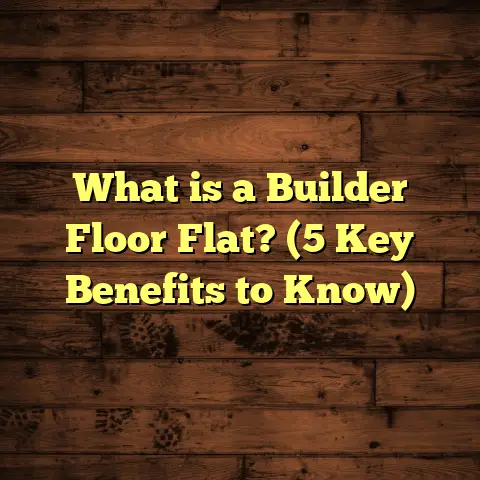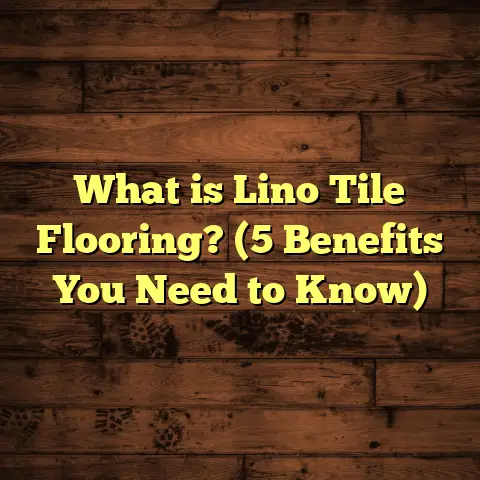What is Flooring Trim? (5 Essential Benefits You Must Know)
I’ve always believed that flooring is one of the most critical parts of any home renovation or new build. But if you ask me what really finishes off a floor and makes it look professionally done, I’ll tell you it’s the flooring trim. I mean, you can pick the fanciest hardwood or sleekest laminate, but if you don’t take care of the edges with the right trim, your floor will look half done—like a painting without a frame.
Flooring trim might seem like a small detail, but over the years working as a flooring contractor, I’ve learned it’s one of the best options for improving your floor’s durability, aesthetics, and overall value. It’s that final touch that ties everything together.
If you’re planning a flooring project or trying to improve your current floors, understanding flooring trim will help you make better choices that pay off in the long run.
What is Flooring Trim?
Let’s start simple: flooring trim is the material used to cover the gaps and edges where your floor meets the walls or other surfaces. You’ll usually find it as baseboards, shoe molding, quarter rounds, or reducers—each serving slightly different purposes but all related to finishing your floor edges.
When I was new to flooring installation, I thought trim was just decorative. But overtime, I realized it’s much more than that. It’s about function and protection, not just aesthetics.
For example, when wood floors expand or contract due to humidity changes (and they always do), expansion gaps are left around the edges to prevent buckling. Flooring trim cleverly hides those gaps so your floor can move without looking unfinished or messy.
There are lots of materials used for trim: solid wood, MDF (medium-density fiberboard), PVC, and even metal in some cases. Depending on your flooring type and room conditions (like moisture levels), you pick the trim that fits best.
Why Flooring Trim is the Unsung Hero of Your Floor
Here’s the thing: no matter how gorgeous your floor is, if it doesn’t have proper trim, it looks incomplete. Flooring trim bridges the gap between your flooring and walls, making sure there’s no unsightly space or sharp edges.
I remember working on a project where a client had installed beautiful engineered hardwood but skipped the trim to save money. The gaps around the edges collected dust and dirt fast, and it looked like a construction zone rather than a finished space. When we installed shoe molding around the edges later, the room instantly felt more welcoming and “done.”
1. Flooring Trim Gives Your Floor a Clean and Polished Look
One of the first benefits I noticed with flooring trim is how much it improves the overall look of a room. Without trim, even the best floors can appear sloppy because small imperfections at the edges are exposed.
When installing floors—whether hardwood, laminate, vinyl planks, or tile—it’s nearly impossible to get a perfect fit against uneven walls or baseplates. Walls can be crooked or have bumps. Flooring trim covers these inconsistencies nicely.
Personal Story
I once installed laminate in an older Victorian home where walls were far from straight. The floorboards had to be cut carefully but still left small gaps near walls. Adding quarter round molding made all those uneven edges disappear from sight. The home owner was thrilled with how professional it looked.
Types of Trim That Enhance Appearance
- Baseboards: These are larger trims that cover the joint between floor and wall. They come in many styles—from simple flat boards to intricate moldings.
- Quarter Rounds: These are curved trims often used at baseboards for a smooth transition.
- Shoe Molding: Similar to quarter rounds but thinner; often used to cover expansion gaps.
- Reducers: These trims help when transitioning between floors of different heights (like hardwood to tile).
Each type helps polish the look depending on what your floor needs.
2. Protects Walls and Floors from Damage
You might not think about it, but walls take a beating over time—especially near floors. Vacuum cleaners bump into them. Furniture scrapes them. Even mops can chip paint.
Flooring trim acts like a shield for your walls. It absorbs impacts and prevents direct damage to drywall or plaster.
When I do renovations in rental properties or busy family homes, I always recommend good quality trim because it saves money on repainting walls later.
Real Case from My Experience
A client had kids who loved pushing toys across rooms. Without shoe molding or baseboards, their walls got chipped badly after just one year. After we installed robust baseboards and shoe molding during a remodel, those same walls stayed pristine for years despite heavy use.
Trim also protects the edges of flooring itself. Wood and laminate planks can chip at corners if left exposed. Trim holds everything snug together and prevents damage from foot traffic or cleaning tools.
3. Hides Expansion Gaps for Flooring Longevity
This is one of those technical details that many homeowners don’t realize until they see their floors buckle or warp.
Wood and laminate floors expand and contract with moisture changes in the air—sometimes by as much as 1/4 inch or more in each direction depending on climate.
To allow for this natural movement, installers leave a small gap—called an expansion gap—between the floor edge and walls. If this gap isn’t covered properly:
- Dirt collects there
- It looks unfinished
- The floorboards can shift awkwardly
Flooring trim covers this gap invisibly while allowing wood to breathe and move freely underneath.
A Project Example
In a humid climate where I installed hardwood floors recently, we left standard 3/8-inch expansion gaps around perimeters before adding baseboards and shoe molding. This prevented buckling during summer months when humidity was high.
The homeowner appreciated how seamless it looked while knowing their floors were protected from future damage.
4. Makes Cleaning Easier and More Effective
Here’s something many people overlook: flooring trim helps keep cleaning simple.
Without trim covering those tight edges between floor and wall, dust and debris settle in gaps where brooms can’t reach easily. Over time, this leads to buildup that requires extra effort to clean or even impacts indoor air quality.
Trim creates a smooth transition so you can sweep or mop right up to your walls without worrying about damaging paint or missing dirt trapped in cracks.
Why This Matters in Real Life
I’ve worked in homes with pets and kids where cleaning is a daily chore. Those without trims had constant dust build-up along edges that frustrated homeowners.
When we added shoe molding or quarter rounds during upgrades, they told me cleaning became noticeably easier and less time-consuming because every corner was accessible.
5. Adds Value When Selling Your Home
It may surprise you that such a small detail can influence home resale value—but it really does.
Buyers notice finishing touches like flooring trims because they signal quality work and care taken by owners.
According to research from the National Association of Realtors:
- 70% of buyers pay attention to trim and molding details during house tours.
- Homes with well-finished floors including appropriate trims sell faster.
- Buyers associate these details with overall maintenance and quality craftsmanship.
How I’ve Seen This Play Out
A client once told me their real estate agent said the new baseboards and shoe molding throughout gave their home an edge over similar houses on the market.
The home sold within two weeks for above asking price—proof that small details like trim can have big financial impact.
Choosing the Right Flooring Trim for Your Project
Now that you understand why trim matters so much, how do you pick what fits best?
Consider Material
- Wood: Classic choice for hardwood floors; stainable and durable.
- MDF: Budget-friendly option; easy to paint but less moisture-resistant.
- PVC/Vinyl: Great for bathrooms/kitchens because it resists water damage.
- Metal: Less common but used in modern designs for sleek finishes.
Style Matters Too
Simple flat trims work in minimalist spaces; ornate moldings fit traditional homes.
I always tell clients to think about:
- Existing decor
- Floor type
- Room use (moisture levels)
- Budget
Installation Tips I’ve Used Over Time
- Measure twice before cutting
- Use nail guns for neat attachment
- Caulk gaps between wall and trim for seamless finish
- Paint or stain before installation if possible
How I Use FloorTally To Manage Costs Efficiently
Managing budgets is always tricky in flooring projects because prices vary widely based on materials and labor.
I rely on an online tool called FloorTally for accurate cost estimates based on local pricing data. It lets me:
- Choose materials with precise price points
- Account for labor costs automatically
- Include waste factors so I order enough material without overbuying
- Visualize total project cost including trim installation
Using FloorTally saves me hours each week and helps clients understand exactly where their money goes without surprises later.
If you’re doing a DIY job or working with contractors, having clear numbers upfront means better decisions—and less stress when bills arrive.
Common Questions About Flooring Trim (Answered)
Q: Can I install flooring trim myself?
Yes! If you have basic tools like a miter saw and nail gun, installing baseboards or shoe molding isn’t too difficult. Just take your time measuring cuts accurately and pre-painting if needed to avoid mess later.
Q: How much does flooring trim cost?
Trim costs vary based on material and style but expect roughly $1–$3 per linear foot for materials alone. Labor might add another $2–$5 per foot depending on complexity. Using cost estimation tools helps plan better.
Q: What’s better—quarter round or shoe molding?
Both cover expansion gaps well; shoe molding is thinner so fits flush against baseboards better while quarter round is chunkier with a rounded profile. Choose based on aesthetic preference and floor type.
Q: Can I mix different trim types in one room?
Technically yes but it’s usually best to keep consistency for polished look unless you’re designing intentional accents between rooms or areas with different floors.
Final Thoughts From Someone Who’s Seen It All
After decades installing floors across all kinds of homes—from modest condos to luxury estates—one fact stands out:
Flooring trim isn’t just an accessory—it’s essential for achieving a professional-quality finish that lasts.
If you want your floors to look great, resist damage over time, make cleaning easier, and even increase your home’s value—don’t skip this step.
And if budgeting feels overwhelming? Use tools like FloorTally to get clarity before starting so you can plan confidently without surprises down the line.
So next time you’re thinking about your floors, remember: those small strips of flooring trim are really what bring everything together beautifully.
Got questions about which trims suit your floors? Need installation tips? Just ask—I’ve got plenty of stories and advice ready to share!
If you want me to expand certain sections further with even more details or add specific case studies about installations in different climates or flooring types, just let me know!





